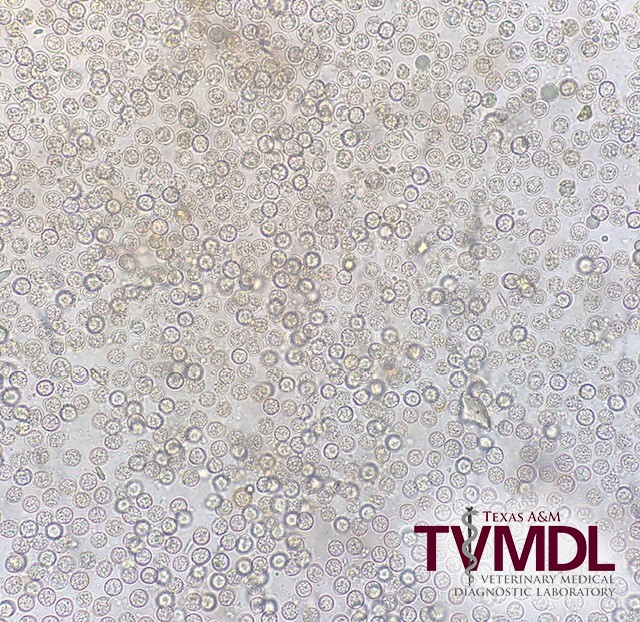An 11-year-old Corgi mix was presented to the veterinarian with intermittent diarrhea and inappetence. History noted the dog had clinical signs of gastrointestinal (GI) disease for the past few months, was current on vaccinations and was fed a raw food diet. A fecal sample was submitted to the Texas A&M Veterinary Medical Diagnostic Laboratory (TVMDL) for testing to rule out intestinal parasitism. Fecal floatation testing revealed a tremendous number of coccidia oocysts (Figure 1).

Coccidia are microscopic, single celled parasites that can infect the intestinal tract of dogs, causing diarrhea. Coccidia are typically identified based on the size and shape of the oocysts shed in feces. However, the oocysts found in this case looked similar to Hammondia heydorni, Toxoplasma gondii, and Neospora caninum. These three coccidia are morphologically similar and the oocysts are almost indistinguishable via microscopic examination due to their similar sizes (9-14 um). Real time PCR for T. gondii and N. caninum was performed on the fecal sample at TVMDL and no DNA was detected, leaving Hammondia heydorni as the only remaining identity for the parasite. Identification of the oocyst is important since T. gondii and N. caninum can cause severe disease in dogs while H. heydorni is largely considered clinically insignificant.
Hammondia heydorni is a coccidian whose definitive hosts are dogs and coyotes. Its encysted form is found in raw meats such as beef and can cause infection when consumed. Typically, the parasite does not cause harm to its definitive host; however, studies have shown that H. heydorni can cause diarrhea in immunosuppressed dogs. H. heydorni undergoes sexual reproduction in the GI tract of the definitive host, forming cysts that are excreted through the feces. The intermediate prey species (typically livestock) then ingest the cysts. Once ingested, H. heydorni attacks the prey’s muscle tissues causing atrophy and continues to reproduce inside the prey. Clinically, treatment for severe cases include sulfonamides and supportive fluid therapy. In order to prevent coccidiosis, raw meat diets should be avoided and fecal contamination should be properly disinfected.
For more information about TVMDL’s test catalog, visit tvmdl.tamu.edu.
REFERENCES
Schares, G., Pantchev, N., Barutzki, D., Heydorn, A. O., Bauer, C. & Conraths, F. J. (2005) Oocysts of Neospora caninum, Hammondia heydorni, Toxoplasma gondiiand Hammondia hammondi in feces collected from dogs in Germany. International Journal for Parasitology. 35, 1525-1537.
Kahn, C. M. (2005). The Merck veterinary manual. 9th ed. / Whitehouse Station, N.J.; Great Britain: Merck & Co.